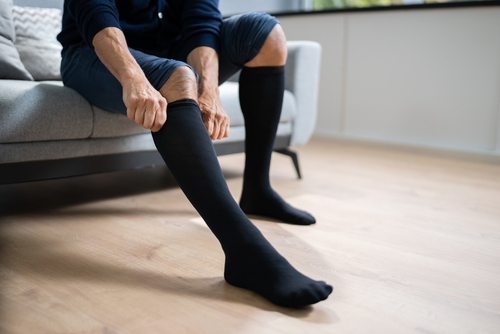Compression Socks: What Are They and Who Needs Them?

It is always an interesting conversation whenever the discussion turns to the type of socks someone wears. I mean how did we even get here? But as awkward as the conversation may seem, the type of socks a person wears might have a significant effect on a person’s health and/or well being. If there is foot pain from plantar fasciitis or bunions, there are socks with bunion cushions or built-in arch supports. If there are issues with the veins in a person’s leg, there are a plethora of compression sock types one could choose from. But what exactly are compression socks and who, and when, are they to be used?
What Are Compression Socks?
It is said that compression socks were invented by German Conrad Jobst in 1950. He, at the time, suffered from varicose veins – these are enlarged, twisted veins which can show prominently near the skin’s surface – which meant that he probably did his own trials for the product.
Compassion socks also help to prevent edema and deep vein thrombosis. When worn properly, the socks create pressure on the muscles, bones, and connective tissues. Compression therapy has a history that dates back to ancient civilizations in Rome and Egypt, where many people used similar leg garments to bind and treat injuries.
What could be considered a breakthrough moment, William Harvey – an English physician – discovered the link between venous stasis and the external pressure in 1628. After that discovery, various compression measures were introduced for therapy including: laced stockings, elastic bands, and tight bandages with resin.
As the years passed, new textile materials began being used for the production of, first compression stockings then socks. For example: natural or cellulose fibers (silk, cotton, coconut) and chemicals (acrylic, nylon, polyester).
What Are The Different Types of Compression Socks?
Firstly, there needs to be a distinction made between compression stockings and compression socks. The main difference between the two is simply the design and the material used in the design. Compression socks are shorter and cover up to the ankle, while stockings can go as high as the thigh.
There are two main types of compression socks, graduated and uniform. Graduated compression provides more pressure around the ankle and gradually gets looser as the sock moves up the leg. Uniform compression provides constant pressure throughout the length of the sock.
Graduated compression socks
Graduated compression socks are the most effective type of compression sock used to boost circulation. They also help the blood in a person’s leg travel back up to the heart against the force of gravity by applying pressure to vein walls from the outside. More blood pumping means more energized legs and less pain and swelling of the feet.
Graduated compression socks are frequently packaged with pressure range labeling. The higher number on the range would indicate the higher amount of pressure on the ankle, while the lower number would indicate the pressure rating on a person’s calf. Compression socks should comprise of breathable material that someone wouldn’t mind wearing for the entire day around their legs and feet.
Uniform compression socks
Uniform compression socks are normally worn to support blood flow to muscles during workouts. Uniform compression socks distribute equal pressure from the ankle and up toward the knee.
Who Needs Compression Socks?
As mentioned above, compression socks are frequently used to reduce swelling of the feet, varicose veins, edema and deep vein thrombosis. Compression socks are also effective against:
- shin splints – an inflammation of the muscles, tendons, and bone tissue around the tibia
- restless leg syndrome – a nervous system disorder that causes an overpowering urge to move the legs
- orthostatic hypotension – a sudden drop in blood pressure caused by a change in posture
- chronic venous insufficiency – a condition in which the veins have problems sending blood from the legs back to the heart
- spider veins – are small, twisted blood vessels that are visible through the skin
- plantar fasciitis – a condition that causes pain on the bottom of the heel
- postural orthostatic tachycardia syndrome – a blood circulation disorder characterized by a heart rate increase from horizontal to standing
- post-thrombotic syndrome – a long-term condition that occurs as a result of a deep vein thrombosis
- lymphedema – a build-up of lymph fluid in the fatty tissues just under the skin.
Compression socks are also quite useful for athletes to wear on their arms, in addition to their legs, to improve oxygen delivery and blood flow while working out or during competition. Some athletes feel that compression socks the effect around the calves and ankles helps kinesthesia and even improves balance.
Compression socks additionally have the reputation of speeding up recovery and reducing muscle soreness after a strenuous workout. Pregnant women who are prone to swelling in their legs, feet or ankles may want to wear compression socks to reduce chances of swelling.
Airplane passengers or crew on long or frequent air flights may want to wear compression socks to help increase circulation and reduce their risk of developing deep vein thrombosis otherwise known as blood clots. And for people on their feet all day at work, compression socks can help reduce fatigue, pain or swelling by increasing blood and oxygen flow in the legs and feet. This is also true for people who have been confined to a wheelchair or have had an extended period with bed rest, compression socks can reduce the occurrence of blood clots.





